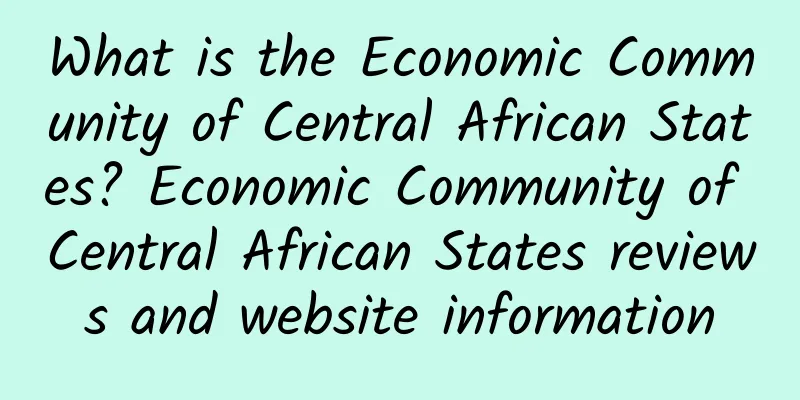What is the Economic Community of Central African States? Economic Community of Central African States reviews and website information

|
What is the website of Economic Community of Central African States? The Economic Community of Central African States (Communauté Economique des Etats d'Afrique Centrale; abbreviated as CEEAC) is a regional economic organization in Africa. It was established in 1983, with its secretariat located in Libreville, the capital of Gabon. Its members include Angola, Cameroon, Central Africa, Chad, Rwanda, etc. It aims to promote and strengthen coordination, cooperation and balanced development among member countries and maintain stable economic development. Website: www.ceeac-eccas.org Economic Community of Central African States (CEEAC): The backbone of promoting regional economic integrationThe Economic Community of Central African States (Communauté Economique des Etats d'Afrique Centrale, CEEAC for short) is an important regional economic organization in Central Africa. Since its establishment in 1983, the organization has been committed to promoting coordination, cooperation and balanced development among its member states to achieve economic stability and sustainable growth. As an important part of the economic integration of the African continent, CEEAC has played an irreplaceable role in promoting regional economic cooperation. CEEAC's historical background and original intentionThe origin of the Economic Community of Central African States can be traced back to 1964, when the then French Equatorial African countries jointly established the "Central African Customs and Economic Union" (UDEAC). However, as time went on, this organization gradually exposed some problems, such as the imbalance of economic development among member states and the inflexibility of the cooperation mechanism. In order to solve these problems and better adapt to the challenges brought by globalization, in 1983, at a special summit held in Libreville, the capital of Gabon, the leaders of various countries decided to reorganize UDEAC into a more modern and efficient organization - the Economic Community of Central African States (CEEAC). CEEAC was established to promote trade and investment within the region, reduce poverty and improve people's living standards by strengthening economic ties among member countries. At the same time, it is also committed to maintaining regional peace and security, ensuring political stability and creating a good environment for economic development. These goals reflect the member countries' common vision for regional economic integration and lay the foundation for the future development of CEEAC. Organizational structure and operating mechanismCEEAC's organizational structure includes multiple levels and institutions to ensure that its policies and decisions can be effectively implemented. The highest authority is the "Conference of Heads of State and Government", which is usually held once a year and is responsible for formulating overall strategic directions and major policies. In addition, there is a ministerial council responsible for overseeing the implementation of specific policies; and standing committees are responsible for dealing with daily affairs and technical issues. The Secretariat is the core administrative body of CEEAC, located in Libreville, the capital of Gabon. The Secretariat works under the leadership of the Executive Secretary-General and is responsible for coordinating activities among member states, managing budgets, and providing support to other institutions. The Secretariat has several departments covering economics, finance, trade, agriculture, industry, transportation, energy, education and other fields, reflecting CEEAC's emphasis on comprehensive development. Member States and Geographical ScopeCurrently, CEEAC has 11 member countries, namely Angola, Burundi, Cameroon, Central African Republic, Chad, Republic of Congo, Democratic Republic of Congo, Gabon, Equatorial Guinea, Sao Tome and Principe and Rwanda. These countries are located in a vast geographical area in central Africa and have rich natural resources, diverse cultures and historical traditions. Geographically, CEEAC member countries cover the central region of sub-Saharan Africa, with a total area of more than 4.7 million square kilometers and a total population of nearly 200 million. This region not only contains a large amount of oil, natural gas and mineral resources, but also has vast forests and fertile land, providing unique conditions for agricultural development. However, due to historical reasons and geographical location, the infrastructure of many member countries is relatively backward and the level of economic development is low, so regional cooperation is needed to achieve complementary advantages and common development. Main functions and objectivesThe main functions and objectives of CEEAC can be summarized as follows:
These goals are not only in the common interests of member states, but also contribute to the development of the entire African continent. For example, CEEAC actively participates in international cooperation under the framework of the African Union (AU) and the United Nations, and strives to achieve the long-term development goals set out in the 2063 Agenda. Concrete measures for economic cooperationTo achieve the above goals, CEEAC has adopted a series of specific policy measures and action plans. The following are some examples of cooperation in key areas: 1. Trade and investmentCEEAC is committed to simplifying cross-border trade procedures and reducing tariffs and non-tariff barriers to promote the exchange of goods and services between member countries. In recent years, the organization has also strengthened its attractiveness to foreign investment and encouraged multinational companies to invest in the region. For example, by setting up a one-stop service center, it provides companies with convenient registration and approval processes, reducing time and costs. 2. Infrastructure constructionInadequate infrastructure has always been one of the bottlenecks restricting the economic development of Central Africa. To this end, CEEAC has launched a number of large-scale projects, including road networks, railway systems and power transmission lines connecting member countries. Among them, the "Great Lakes Energy Corridor" plan is a typical example. The project aims to use the hydropower resources of the Congo River Basin to provide clean and cheap electricity supply to the entire region. 3. Agriculture and food securityAgriculture is the economic backbone of most CEEAC member countries, so the organization attaches great importance to agricultural production capacity and food security. By promoting modern agricultural technology, improving irrigation systems and strengthening farmer training, CEEAC has helped member countries improve crop yields and quality. In addition, a regional food reserve system has been established to cope with risks brought about by natural disasters or market fluctuations. 4. Environmental protection and sustainable developmentCentral Africa has one of the largest tropical rainforests in the world and one of the most biodiverse regions. In order to protect this precious resource, CEEAC has formulated strict environmental regulations and has carried out a number of ecological protection projects in cooperation with other international organizations. For example, the "Congo Basin Forest Partnership" program aims to reduce illegal logging and carbon emissions while promoting sustainable livelihoods for local communities. Challenges and future prospectsAlthough CEEAC has made remarkable achievements in the past few decades, it still faces many challenges. First, there are large differences in economic development levels among member countries, which leads to imbalances in the cooperation process. Second, political instability and security issues in some countries may affect the overall development process of the region. In addition, funding shortages and insufficient technical capabilities are also factors that restrict the further development of CEEAC. In the face of these challenges, CEEAC is taking positive measures to address them. For example, by strengthening internal governance reforms to improve transparency and accountability; seeking more support from external partners to expand financing channels; and cultivating local talents and improving technical capabilities. At the same time, with the changes in the global economic landscape, CEEAC is also actively exploring new development opportunities, such as digital transformation, green economy and renewable energy. Official website: www.ceeac-eccas.orgIf you want to learn more about the Economic Community of Central African States, you can visit its official website: www.ceeac-eccas.org . The website provides a wealth of resources and data, including the latest news, policy documents, research reports, and relevant information on member countries. Whether researchers, entrepreneurs or the general public, they can obtain valuable content from it and deepen their understanding of CEEAC and its work. ConclusionAs one of the most important economic cooperation organizations in Central Africa, the Economic Community of Central African States carries the mission of promoting regional prosperity and stability. Through unremitting efforts, CEEAC has successfully promoted many milestone projects and initiatives, bringing tangible benefits to member countries. Looking to the future, with the deepening development of globalization and the official launch of the African Continental Free Trade Area, CEEAC will usher in greater opportunities and challenges. We have reason to believe that with the joint efforts of all member countries, this organization will continue to play an important role and contribute to the realization of the African dream. |
Recommend
Common types of fruits and their functions
Are you familiar with the types and functions of ...
Scrophularia ginseng porridge
There should be few friends who have eaten Scroph...
The efficacy and function of pepper
Women who love cooking know that pepper is a good...
The benefits of eating squash
Squash is common in tropical areas and has a swee...
What are the benefits of eating betel nut
Betel nut is a unique food in southern China and ...
What foods can replenish qi and blood?
When the body lacks Qi and blood, it will cause a...
What is American V Magazine like? American V Magazine reviews and website information
What is the website of American V Magazine? Founde...
The efficacy and function of medicinal dandelion
Dandelion is a very good Chinese herbal medicine....
What is Dresden Dynamo like? Dresden Dynamo reviews and website information
What is the website of Dresden Dynamo? SG Dynamo D...
The benefits of eating dragon fruit
Dragon fruit, also known as dragon beard fruit or...
What is Vassarette like? Vassarette reviews and website information
What is Vassarette? Vassarette is a famous underwe...
The efficacy and function of Gongli
Gongli is a variety of pear. It is a relatively l...
Tremella and Mung Bean Porridge
How much do you know about the recipe of Tremella ...
What can't be eaten with rabbit meat? What is incompatible with rabbit meat?
Rabbit meat is a common meat ingredient on people...
How is Gunma University in Japan? Reviews and website information of Gunma University in Japan
What is Gunma University in Japan? Gunma Universit...









